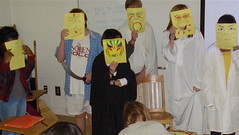First emperor review . . .
1. The life of Shi Huang Di: a) 1200 BCE b) 200 BCE c) 200 AD d) it is fictitious.
2. Shi Huang Di’s version of the Great Wall was called a “precursor” to the later Great Wall. Precursor means
a) small version b) earlier example c) moveable pointer
3. Tomb: a) monument b) mound c) subterranean
d) mausoleum.
4. As an audacious autocrat the First Emperor burned and banned writing by __. a) Lao Tzu b) Tao c) Confucius d) Buddha.
5. The importance of his reign is intact after 2 millennium. That would be some a) 200 b) 2 thousand c) 2 million years.
6. As a young king, Huangdi began construction on a) roads b) canals c) obeisks d) his mausoleum.
7. When a youth becomes king he usually has a powerful member of the court who acts as his guide to decision-making. That person’s title? a) proxy b) consort c) regent d) caretaker.
8. Shi Huang Di’s period of rule was preceded by a period of civil war known as a) Warring states b) Confucian c) Primitive d) Troubles.
9. Shi Huang Di unified China economically by standardizing the Chinese units of measurements such as weights and measures, the currency, the length of the axles of carts (so every cart could run smoothly in the ruts of the new roads). He was not able to upgrade the legal system. T / F
10. What was his most important reform, according to Wikipedia?
a) silk b) currency c) writing d) elephants.
11. Shi Huang Di seriously sought the elixir of life, a magical potion which reputedly would enable immortality.
What is an elixir? a) health-giving drink b) magical cape or hat c) a pool of magical water d) hallucinogenic drug.
12. The huge terra cotta army buried with Shi Huang Di lies near which city? a) Beijing b) Shanghai c) Xi’an d) Hong Kong.
13. Qin survived an attempt at violent overthrow by a rival. Such a revolutionary attempt to take over the kingdom is called a
a) coup b) massacre c) liaison d) decapitation.
14. Qin, once known as King Zheng, tried to create a meritocracy in his governmental workers. T / F
15. Qin declared the symbol of his reign was fire and the color of all royal garments was red. T / F
16. The tribes which threatened the empire from the north were migratory, or a) golads b) morads c) nomads d) rolling stones.
17. In one of his greatest projects, the Ling Qu Canal was dug by Qin in the a) north b) south of the nation.
18. Epang Gong refers to a a) concubine b) palace c) river d) ruler in the city of Xi'an.
19. Many of the people in the Chinese court were referred to as eunuchs. This means that they were a) congenital b) silly c) asthmatic d) castrated.
20. Qin's main tomb has been exhumed but was closed to await more advanced archaeological technology. T / F
1. b 2. b 3. d 4. c 5. b 6.d 7. c 8. a 9. F 10. c 11. a 12. c
13. a 14. T 15. F 16. c 17. b 18. b 19.d 20. F
skip to main |
skip to sidebar
For students and parents who love education and exploration of the social sciences . . .
Search This Blog
Followers
Blog Archive
-
▼
2010
(346)
-
▼
April
(32)
- Hard Working Substitute Wei: "Not One Less" Wei Essay
- A quiz on the Odyssey of a Chinese Teen in Not One...
- Grab some chopsticks and bring them to class on Tues
- This weekend: Artbreak, Night of One-Acts, Relay f...
- Drop outs often find their way into the criminal j...
- Not One Less quiz on Thurs: see previous questions...
- Constructed response to the list of Japanese compa...
- Making Tibetan Buddhist flags in geography class o...
- The NY Times describes 36 hours in Kyoto, the impe...
- Product placement in Not One Less: Coca-Cola China
- Thurs reading comprehension quiz on Not One Less a...
- Vietnam vet interview: 15 pts / Book report: 20 pts
- The First Emperor Quiz
- Not One Less created by one of China's most succes...
- Final exam schedule May 25 - 27, 2010
- Wei Minzhi in Zhang Yimou's movie Not One Less
- Bonus credit for attending Shakespeare in the Cent...
- Week of Ap 18: Quiz on Wed and presentation on Fri...
- Mapping Magnet High and the area
- Alchemists and mercury
- Creating a dramatic presentation on the Middle Kin...
- Chinese tombs and embalming
- Map quiz followed by giant paper Chinese Mask maki...
- iLeap & GEE tests Mon - Wed, April 12 14, 8:30 am ...
- Bonus credit: attend the Magnet Choir's performanc...
- Qin Shi Huangdi review: the First Emperor and his ...
- Which would you rather carry to school: a laptop a...
- Indie work on China
- Chinese history via research and skits
- Chine 中国 - Shanghaï 上海
- Coming to the RFC: The Films of Ang Lee, April 5-9
- Domino theory and a gorilla in the living room: th...
-
▼
April
(32)

